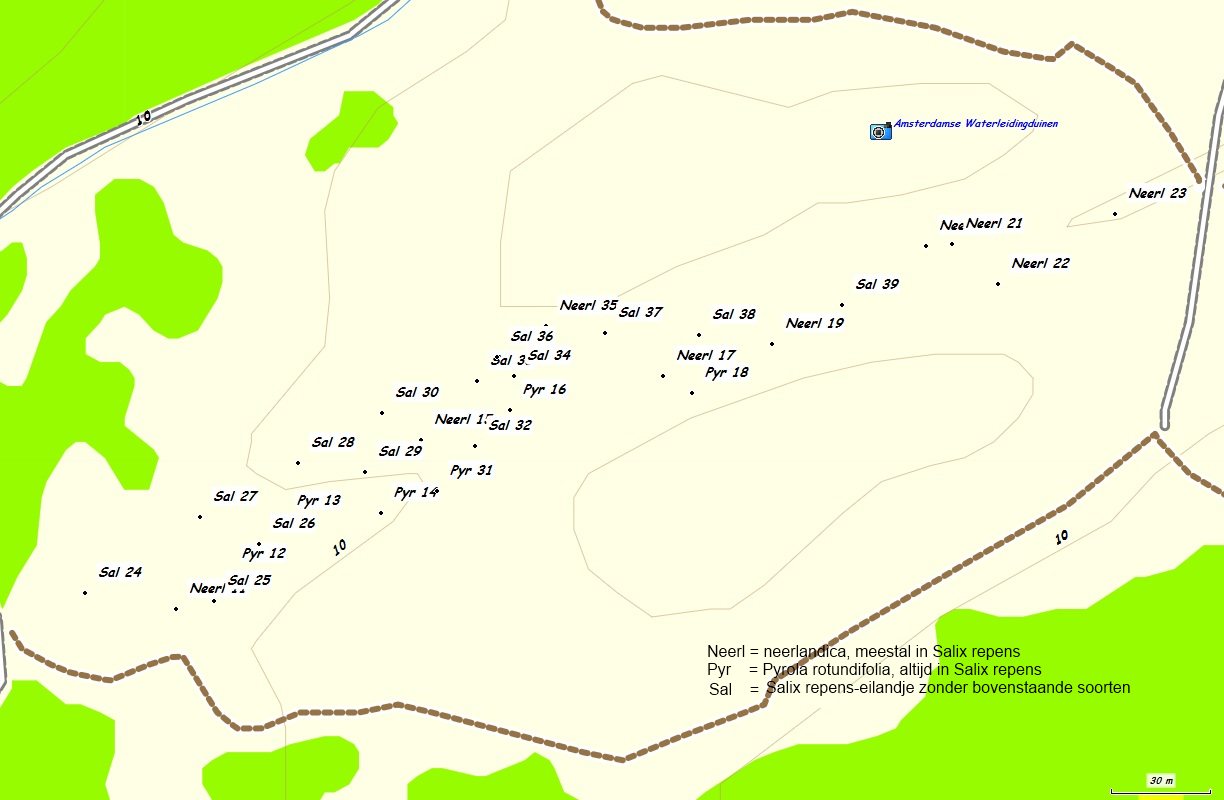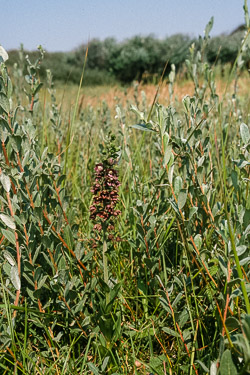
Because most of my observations were made in the AWD, it seems useful to give attention to this area in a special subpage.
The first location where I recognized neerlandica was in the "Vinkenveld" in a dry Creeping Willow vegetation.
In an open area in the AWD subsp. neerlandica occurred scattered over a fairly bare
slope partially covered with Creeping Willow and
some Sea Buckthorn (Hippophaë rhamnoides). I call this location the
"Neerlandica-valley". The plants sometimes stood in the bare sand, but mostly in "islands" of
Creeping Willow vegetation. In 1985 16 specimens of subsp. neerlandica were counted,
24 in 1986 and 44 in 1987 on the same spot. In 1988, only 7 flowering and 3 non-flowering
plants were found. The entire site became less vegetated than in previous years; the
Crested hair-grass also became more scarce and less flourishing.
Over the years, the focus of the subsp. neerlandica population transferred to the eastern
half of the valley. At the higher places at the western end
of the valley the numbers of Wood Sage (Teucrium scorodonia) gradually increased,
presumably as a result of decalcification since it prefers acidic soils. However, in some
places it seems that there was still enough calcium available for subsp. neerlandica to
continue to grow. In 2009, the valley was accurately mapped using GPS. In that year 27
specimens of subsp. neerlandica were found flowering and one non-flowering.

After the dry summer of 2010 not one specimen was found. In 2011 the spring was very dry and, probably as a result, only 5 specimens were found. So there were large fluctuations in numbers. Furthermore the number of fallow deer rose steadily and that led also to the decline. Between 2014 and 2016 no plants were found anymore.
In the beginning of 2016 a game fence was placed around the last known locality in the
dry Creeping Willow vegetation. On 20 September 2016 15 specimens of neerlandica
were found within the fence, of which six had flowered. The plants were mostly very small. It
was a surprise to find so many specimens after some years of absence. Were the plants
after 2012 always eaten so early in the year and therefore never observed? The small size of
the plants seems to point out, that they had gone through difficult times. In 2017 10 flowering
specimens were found and one non-flowering. Seven of the flowering plants were clearly
taller than those in 2016! A wasp was active as pollinator, but it could not be captured for
identification.
Among other plants Pyrola rotundifolia and Jasione montana were flowering
again within the fence and also Salix repens (Creeping Willow) was thriving. Let's
hope, that the number of fallow deer can be reduced in some years, so that the
Amsterdamse Waterleidingduinen can prove again its status of Natura 2000-area.

The height of the subsp. neerlandica plants in this habitat was rarely
more than 25 cm, rarely up to 50 cm. The tallest plants were those growing among the
Creeping Willow. In 1986 there were some
specimens with not developed, withered inflorescence, probably due to low summer rainfall.
In this regard, the August flowering time does involve the risk of desiccation, especially for
plants growing in the open in dry sand. On the other hand, as plausibly explained by VÖTH
(1982), this period is an adaptation to the time when the wasps which pollinate E. helleborine
switch from eating other insects (in order to feed the larvae)
to sweet substances, so that they are attracted to nectar-rich Epipactis flowers.
On many visits to the site in August it was obvious, that almost all the flowers
had been visited by pollinating insects since the rostellum and pollinia had already
disappeared. These were still present only in newly opened flowers. Therefore, very frequent insect visits
must have taken place. At other localities it was also found that almost all flowers must have
been visited by insects during the main flowering season.
Despite the fence, the population at this site has declined. The summers of 2018 and 2019 were dry and many flower buds were desiccated. The year 2020 was a better year; spring was wet and the drought started later. In recent years, however, the small population at this site has continued to decline.
Areas of dry Creeping Willow vegetation also occurred elsewhere in the Amsterdamse
Waterleidingduinen before the overpopulation by fallow deer.
Such sites now still occur among others in Meijendel (ZH) and Schoorl.
The regulation of the fallow deer population has started at last in 2016, but it will take maybe
ten years to reduce the population sufficiently.
In the pine woods subsp. neerlandica mostly grew with few other vascular plants and
they were easily visible and soon eaten by rabbits and later chiefly fallow deer. Plants growing in
some taller grass were left untouched. Various studies on the behaviour of rabbits have indeed proved that
they prefer to graze in areas with short grass.
Some much more open and grassier pine wood habitats are found on the estate Koningshof and in its surroundings.
Among Creeping Willow vegetation on damp ground, the supply of food for herbivores was much
larger so that, not surprisingly, the damage here was initially less, but even there all plants
disappeared in the end.
One site was near a supply channel with areas of
sedges and Creeping Willow growing along areas of reeds. Eight specimens of subsp.
neerlandica were found scattered among the Creeping Willow. Growing nearby was
Southern Marsh Orchid (Dactylorhiza praetermissa) and Common Spotted Orchid
(Dactylorhiza fuchsii). On the other side of the habitat there was a place
where many Pyrola rotundifolia, Seaside Centaury (Centaurium littorale) and
Lotus spec. grew among the Creeping Willow. As usual in such habitats,
the subsp. neerlandica grew very scattered. As a result of succession and/or
changes in the water level and later by overgrazing by fallow deer, the site has since changed a lot.
Another wet habitat was located in the outer dunes on the western border of the AWD. Here, in a fairly deep hollow the groundwater just reaches the surface. The Creeping Willow vegetation was situated on the slope of the hollow. Moisture indicators -Water Mint (Mentha aquatica), Woody Nightshade (Solanum dulcamara) and Gypsywort (Lycopus europaeus)- occurred as well as European Dewberry (Rubus caesius) which also grows in drier areas. In this Creeping Willow zone 20 specimens of subsp. neerlandica were found. These subsp. neerlandica all showed the typical characteristic features, while the flower colour ranged from yellow-green (with only some red at the inner side of the petals) to a dark red colour reminiscent of E. atrorubens. In recent years, these plants have not been re-found, nor Marsh Grass-of-Parnassus (Parnassia palustris) which also grew here. Drinking fallow deer made a muddy and bare pool of this promising location.
 | 
Plant and habitat in damp Creeping Willow vegetation |
Habitats in deciduous bushes were often not very lasting and after the increase of the fallow deer population they disappeared.
Given the decline at the site in the "Vinkenveld", the discovery of new sites was very pleasing.
Within a large fenced-in area in the southeast corner of the dune area one specimen was found in 2020. In the next year there were two
specimens, but in 2022 and 2023 they could not be found again. Fortunately, in 2022 in the same fenced-in area in a different location,
6 specimens were found under White Poplar. Three specimens grew close together with a forth nearby.
In a distance of 2 and 3 meters there were two other plants. Other ground cover consists mainly of grasses. The Poplar bush
is not very dense.
In 2022, in a moist dune valley, two specimens were found inside the fence and one outside it. The latter had been eaten off by fallow deer.
The situation in 2023 was the same, but to our surprise we found 32 specimens on the other side of the valley, spread over an area of about
25 x 7 meters and just outside the fence! Temporary grazing cages have been put over most of the specimens and in the winter of 2023/2024
the fence has been extended around this site.
This makes this site by far the largest in the AWD, and finally there is again a large, healthy growing site of neerlandica.
The survival of the species in the AWD thus seems to be secured for the time being. It is even quite possible that the species will continue
to expand here in the coming years.
 |  |
On the description of the "dunes near Zandvoort and Vogelenzang" in the article by Dekker & Kreutz (2017), some comments can be made. The biotopes as described in the article seem to be derived from my first article on neerlandica (1989), although a reference is lacking. Some statements, however, are not correct or now obsolete.
Dekker & Kreutz (2017) write: "In the dunes near Zandvoort and Vogelenzang (North Holland), the dune form grows on dry dune slopes, in damp birch woods, damp Creeping Willow vegetation and in pine woods. Sometimes plants are found in the light shade of thickets. On dry dune slopes, they prefer to grow in Creeping Willow vegetation, together with Sea Buckthorn (Hippophae rhamnoides) and Crested Hair-grass (Koeleria macrantha), in some places even in bare sand without any other vegetation. In pine forests, the plants are often found in very species-limited vegetations in humus of pine needles, sometimes even without other accompanying plant species."
"Damp birch woods" is a generalization of only one discovery of a number of - not characteristic - plants in one birch wood in 1986. Later they were no longer found there, which was also mentioned in the article (1989). It is therefore not obvious to place this type of biotope directly in the list as second or even at all, especially since the population in question was described as non-characteristic.
"Dry dune slopes" must - at least in the area in question - be understood as "dry dune slopes with Creeping Willow vegetation". There were sometimes specimens of neerlandica in the bare sand, but never very far from Salix repens-vegetations. Dekker & Kreutz (2017) and the 1989 article mention also Sea Buckthorn, but over the years it has become clear that Sea Buckthorn was only a coincidentally present species at the site in question. The chance to find the taxon between Sea Buckthorn is many times smaller than between Creeping Willow and in those rare cases Creeping Willow is never far away. It would be interesting to study the role of the mycorrhiza of the Creeping Willow in the establishment of neerlandica. So far there have been only a few suggestions for further research by Kuiper, Oostermeijer and Gravendeel (2009).
The Crested Hair-grass grows never between the Creeping Willow, but on its edge or away from it. Incidentally, slightly more to the north in Overveen, neerlandica also occurs between higher and denser grass and in moss, partly without Creeping Willow in the neighbourhood.
In 2017 the presence of neerlandica in the described area was as follows: The populations in pine woods had disappeared since many years, mostly due to the growing numbers of fallow deer. All populations in damp Creeping Willow vegetation had also disappeared. Only one population in dry Creeping Willow vegetation had been able to maintain itself (with sharply declining numbers) until 2012 and reappeared after it was fenced in 2016.
In that sense, the text of Dekker & Kreutz (2017) was not up-to-date at all.